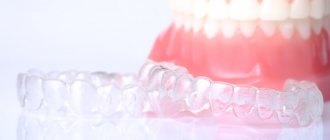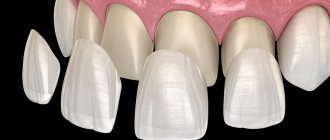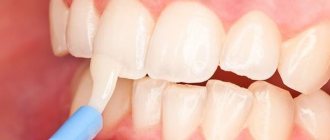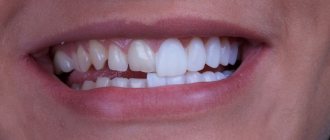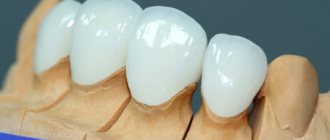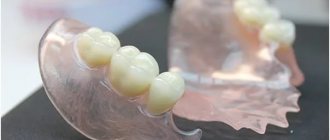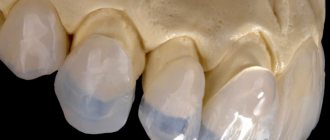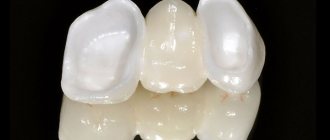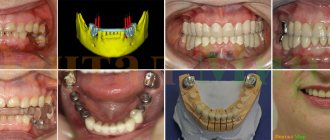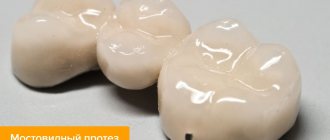Dental veneers are a type of prosthetics that covers the front part of the tooth. As a result, it looks much more aesthetically pleasing. Dental veneers are microprostheses. With their help, you can restore the shape and color of one tooth or a whole row.
Restoration with veneers involves fixing them to the front part of the tooth. They are used to restore the appearance of teeth that fall into the smile line.
The best veneers are virtually indistinguishable in appearance from real teeth. Their color is selected to match the natural one.
In dentistry, veneers are used when whitening or restoring enamel by other methods does not provide the desired effect. Restoration is carried out as soon as possible.
What are veneers and why are they needed?
Veneers should be made to restore the aesthetic appearance of your smile. It is better to place them in pairs so that the teeth look the same. The pads look like real ones. You can install up to 10 teeth on both jaws.
Dental veneers are a type of prosthetics that covers the front part of the tooth. As a result, it looks much more aesthetically pleasing.
Veneers are needed if:
- not satisfied with the natural color of your teeth;
- restoration of the integrity of the enamel is required;
- you need to change the size and shape of the tooth;
- Correction of enamel abnormalities is required (for example, if there is hypoplasia);
- to eliminate interdental spaces.
Veneers mask any imperfections, making your smile beautiful.
Where to install temporary veneers
In the network of family dental clinics ILATAN.
- Here, experienced professionals will take care of your dental health.
- The most comfortable treatment is ensured by a caring attitude and the most modern equipment.
- To work with clients, ILATAN uses only high-quality materials.
- Temporary veneers installed in our clinics have a natural appearance.
- You can be in public places with them, laugh and smile calmly, without worrying about the appearance of your teeth.
For what purposes do dentists use veneers?
Dentists use veneers for dental prosthetics. Unlike a crown, they are placed only on the front part of the tooth, hiding its flaws. Teeth with onlays look both aesthetically pleasing and natural.
If other restoration work has not produced the desired effect, and the patient wants to look different with a more beautiful smile, custom dental veneers are also used. The dentist can also prescribe them if there are large gaps between the teeth. In the clinic, onlays can be fixed to both the lower and upper teeth.
Veneers for aesthetics
Veneers can make your smile look great. At the same time, it can look natural. Veneers on the front teeth can change their color, which has deteriorated after root canal treatment and the use of tetracycline. They are also excellent for correcting short, misshapen teeth. To do this, veneers are fixed to crooked teeth.
You can install veneers to eliminate gaps between teeth and solve the problem of a gummy smile. Overlay veneers can also help if there is weak muscle tone in the lower area of the face and skin. The color of veneers is selected individually in each case. When installed on chewing teeth, you can achieve a lifting effect for the cheekbones. Even if there is one problematic front tooth, this problem can be easily solved.
Functional purpose of veneers
The use of veneers can correct not only aesthetic problems, but also bite problems. In this case, we are talking about the incorrect relationship of the teeth. This is what needs to be corrected.
Microprostheses will allow you to make your jaw look correct. They are able to adhere well and eliminate various defects, including cracks in the teeth, uneven rows, and existing gaps.
Is it worth putting veneers on the weight of the teeth? Theoretically, this is possible, but most often they are fixed only on the smile line - 8 lower and 10 upper teeth.
Situation: veneer failed
In practice, there were cases when the veneer fell off. How to fix? You need to assess the situation and carefully study the problem, and the doctor will suggest a solution.
If the material has simply peeled off, then you need to remove it with careful movements (so as not to damage it).
If you see in your mouth that one part has peeled off, then there is a possibility that the device remains intact. If the veneer falls off as a whole, then the doctor will definitely be able to fix it in place.
In case of obvious breakdown of the material, the dentist will have no other solution but to replace it with a new one.
How can you tell if the entire veneer has fallen off? You need to look at the condition of the fallen element. If it has a symmetrical and rounded shape, then the veneer is intact. If you look closely at the tooth and see a residue on it, then the veneer is 100% broken.
In order to help the dentist with further treatment, you must show him the fragments. It is recommended to save all parts of the broken material. To do this, you need to fill a small box with cotton wool and put the debris there.
Next, you need to report the incident to the doctor. The doctor will solve the problem. But in general, the potential risk of such a problem is small. The tooth will remain without protection for some time (two weeks). There will be no significant changes in him for weeks.
Veneer detachment can be detected independently. It happens that you feel a rough surface (as opposed to a smooth veneer) in your mouth. The tip of the tongue undergoes irritation. And yet, a ground tooth will definitely react to temperature changes, since the surface has no protection.
And in the future, carefully analyze the situation and determine what actions you took could cause the breakdown. Once you find the answer, never repeat such actions again. If you cannot determine, consult your dentist.
What you need to know before installing veneers
Before installation, you need to decide on the material and coordinate the color.
Before installation, you need to decide on the material and coordinate the color. You also need to know that a layer of enamel will be removed from the hard tissue of the tooth. What it will be is determined based on the thickness of the veneer.
First, patients are fitted with temporary veneers. The final version is then produced and delivered for daily use. If you don’t want to grind down your tooth, it’s better to choose thinner designs – lumineers.
Are veneers right for you?
Anyone who has no contraindications to them can have orthopedic structures installed. The main purpose of veneers is to eliminate visual defects of teeth.
If there is a discoloration of the enamel, chips, stains, or other defects, overlays are indicated for use. With their help, you can cope with both trema and diastema, and lengthen or shorten teeth. An aesthetic onlay can also visually correct the position of individual units of a row of teeth, for example, slightly rotate a canine.
Indications for installation
Indications for the installation of turnkey veneers are as follows:
- there is a pronounced yellowness of the enamel;
- the shape of the tooth is irregular;
- there are old fillings whose color is clearly different from the enamel of your teeth;
- there are defects in hard tissues;
- have fluorous teeth;
- change in shade after depulpation;
- there is enamel erosion;
- to straighten a misaligned tooth;
- you can use overlays to create a Hollywood smile;
- the teeth are wedge-shaped;
- stains and chips appeared on the tooth;
- Tremas and dysthemas are present.
If there are diseases such as necrosis, enamel erosion or hypoplasia, veneers can be an excellent solution. With necrosis, the enamel is destroyed. Erosion is signaled by the appearance of oval or round shaped destruction of hard tissue. Hypoplasia is characterized by the absence of part of the enamel. With fluorosis, white spots appear on the enamel, which then turn brown.
Contraindications
Veneers should not be installed in the following cases:
- insufficient volume of enamel;
- there are some types of bite pathologies;
- lack of a large number of chewing units;
- bruxism;
- destruction of more than half of the tooth.
A doctor will help determine contraindications. To do this, they undergo an examination of the oral cavity.
Veneers pros and cons
Installing veneers has pros and cons. Fixing the structure takes only a couple of weeks. After this, your teeth will look perfect, both shape and color.
On the downside, your teeth may become sensitive. Eating very hot or cold food will be problematic. However, such inconvenience occurs very rarely and is rather the exception.
Which veneers to choose
Which veneers are right for you? It all depends on the indications determined by the dentist. The choice should be made based on the strength characteristics, the desired shade, and the scale of tooth destruction.
It also takes into account how many veneers will be needed. You can put one overlay, or 10 on each jaw.
Contraindications to the use of veneers
- Inability to preserve more than 50% of the enamel during preparation;
- Teeth with removed pulp;
- Parafunctions of the masticatory muscles - non-functional contractions (bruxism - grinding teeth at night and/or daytime or clenching - strong clenching of teeth);
- Pathological types of bite (for example, straight, when the cutting edges of the front teeth are connected end-to-end);
- Carious lesions and/or fillings/restorations;
- Poor oral hygiene;
- Temporary teeth;
- Teeth after intensive fluoridation (relatively temporary).
The depth of preparation depends on the clinical situation. Thus, changes in color require an expansion of the boundaries of the preparation (greater coverage of contact surfaces, overlap of the incisal edge) compared to a change in tooth position (dystopia, for example, palatal inclination or position, a thin layer of enamel).
Veneer manufacturing technology
All methods for producing veneers can be systematized as follows:
- Layer-by-layer application. In this case, the onlay is made on platinum foil, which is fixed around the ground tooth on a plaster model. Afterwards the mass is fired. The technician applies the ceramic and fires it. The cost of this technology is lower than that of others.
- Casting method. Wax overlays are modeled on the model. Then they are transferred to the sprue and packed in a special mass. Next, a frame is formed under vacuum conditions. After casting, coloring occurs. Veneers made in this way have an excellent fit.
- Computer modelling. It will take several hours to make a veneer: at least 1 hour for milling and a few more hours for the dental technician to finish the veneer. It is possible to install a veneer in this way within one day, if you visit a doctor in the morning and take a scan of the tooth, and come back in the evening to fix the finished veneer. The structure is attached to the tooth with a material that hardens on its own.
Making ceramic veneers
After collecting the patient’s medical history and clarifying his wishes, the doctor begins preparing the enamel. There are several main stages of work:
- making Wax-up - an example of a future design on a model;
- transfer of this option to the oral cavity - Mock-up;
- cleaning enamel from food and plaque;
- selection of the desired shade;
- preparation of enamel to the desired thickness;
- making a cast of the jaws;
- installation of temporary structures;
- casting a model from plaster;
- production of ceramic veneers;
- fitting of the overlay, correction and fitting;
- installation and fixation of the veneer using a special composition.
Manufacturing of composite veneers
Composite veneers are thin overlays fixed to the front of the tooth. They are made from filling material. They are placed directly in the oral cavity. Their service life is 5 years.
The production process looks like this:
- a specialist examines the oral cavity, identifies teeth that require the installation of onlays;
- composite material is applied;
- teeth are sharpened;
- composite restoration is carried out;
- the pads are sanded.
How to install veneers on teeth
Veneers are installed only on healthy teeth.
Veneers are installed only on healthy teeth. That is, gum disease and caries should be treated initially.
- First, the color is selected using a special scale.
- Then the tooth is turned or prepared.
- Next, an impression is taken, in each case individually.
- Afterwards, temporary linings must be attached.
- Then the veneers are directly fixed using adhesive technology to cement, which is then polymerized using a special lamp. The process takes up to 90 minutes.
- Once the pad is fixed in the correct position, the glue is dried with air. How are veneers placed without grinding down teeth? This is only possible in one case: if you have chosen more expensive analogues in the form of lumineers.
With turning
In most cases, tooth preparation is necessary before installing veneers. The technique consists of making special grooves on part of the tooth. The depth is determined using a special drill. Treatment is carried out up to the gum. The enamel is removed to a depth of 1 mm.
The teeth for veneers are polished and sprayed with a degreaser. Then they are treated with a special chemical.
Preparation for veneers can be performed in different ways. This can be a direct method - it is used in the process of fixing straight structures. In this case, there is no need to completely remove the enamel; it is enough to process some areas.
An indirect method can also be used. It is used when veneers need to cover the outer surface of a tooth. If you remove too little enamel in this case, the effect of “horse teeth” may appear.
Without turning
Veneers can be installed without grinding only in one case - if they are expensive lumineers. First, a consultation is held with a specialist. He examines the patient and decides whether it is possible to place onlays without grinding down the teeth.
Fixation is performed over several visits. The overlays are produced in a special laboratory. They are sanded, polished and painted. After a follow-up inspection, they can be installed on the same day.
How to remove veneers
If the pads are attached correctly, they can only be removed in a medical facility. Even if they have moved away from the enamel, it will not be possible to perform the procedure at home. Clinics use 2 main methods:
- cut down The overlay is removed using a bur;
- peel off. The cement is evaporated using a laser device.
Any manipulations are carried out under anesthesia. The patient does not experience any discomfort.
Securing crowns with cement: technology features, pros and cons
The traditional method used by dentists at the start of prosthetics with implants and which has not lost its relevance to this day is as follows.
After comprehensive preparation of the oral cavity in general and the area for dental implantation in particular, the patient is implanted with an implant simulating the root of a tooth, onto which an add-on is installed - an abutment. And already on the abutment, using the same technology as on your own tooth, a crown is installed, fixed with cement.
Among the advantages of this method, it should be noted, first of all, affordability, ease of implementation and preservation of the integrity of the crown. The disadvantages of fixing a crown to an implant using dental cement are:
- entry of excess solution formed during fixation due to extrusion into the space between the gum and abutment. It is impossible to notice this process from the outside, so neither the patient nor the dentist can be sure that the cement has not entered the gum. In this case, there is a risk of inflammation of the bone tissue adjacent to the implant - peri-implantitis. Treatment of such a disease is long, complex and not always successful. A negative prognosis is the loss of the implant and part of the bone tissue, after which it will require its augmentation, and then re-implantation;
- If at least minimal inaccuracies were made when taking an impression and making the crown, its fit to the abutment will not be tight, which means that the dental cement filling this gap will be washed away by saliva over time. Its place will be taken by soft plaque containing pathogenic bacteria. As a result of decementation, the crown will simply fall out, and due to the action of bacteria, the previously mentioned peri-implantitis may begin to develop, followed by loss of the implant and bone mass.
What types of veneers are used in aesthetic dentistry: by type of material
The main criterion for classifying overlays is the type of material used. Veneers can be ceramic, made from a composite mixture, etc. All types of overlays differ from each other. The varieties are also installed differently.
Ceramic veneers
Ceramic veneers require indirect prosthetics. They are pre-made in the laboratory and then placed on the patient.
Among the proposals for front teeth, emax veneers are recognized as one of the best. They are as durable as possible and look aesthetically pleasing. Unlike standard ceramic onlays, E-max is made from pressed lithium silicate ceramic. The composition was developed by the leading German company Ivoclar Vivodent.
Cast glass ceramics
Veneers are produced from cast ceramics, characterized by high performance and aesthetic properties. Their performance is superior in comparison with porcelain. The main advantage is that there is no need for preparation.
Hot press ceramics
Veneers of this type are produced using the injection molding method under high temperature. The results are durable microprostheses that are resistant to chewing loads. They are thin and light.
At the same time, the pads are hypoallergenic and more durable. The main disadvantage is the impressive cost.
Traditional feldspar ceramics
Such veneers are made from a special powder obtained during firing and subsequent cooling of the crushed workpiece. The material has high aesthetic characteristics. It is excellent for dental prosthetics, regardless of their location.
Composite veneers
Composite veneers are inexpensive. Their appearance is natural. Overlays are made from a special material that is applied in layers. They are distinguished by ease of installation, but the quality does not suffer from this.
Porcelain veneers (Hollywood laminates)
Porcelain veneers or lumineers are considered one of the main achievements in dentistry. They look like thin plates and are placed on the front of the teeth. The color of the overlay is selected by the patient together with the doctor. Veneers are simply glued on, after etching the surface of the natural tooth to make it rough.
Zirconium veneers with application
These overlays are formed from an alloy with zirconium. The material is highly durable and perfectly compatible with teeth. The effect of its use is excellent. The only negative is the high cost.
Plastic veneers (temporary)
Temporary veneers are used after the enamel has been prepared and impressions have been taken. It takes time to produce permanent overlays. During this period, already ground enamel looks ugly. To hide the defect, temporary overlays are used. They also perform the function of protecting teeth from bacteria, temperature, food and plaque.
Plastic veneers are attached with adhesive and can be easily removed in the dental office.
Removable veneers - they don’t exist
Are there removable veneers? In fact, there are none. The onlays, which appear in advertising every now and then, are attached to 10-12 teeth in a row. They are flat models with imitation gums. They are attached directly to the teeth.
Manufacturers claim that such overlays are suitable for any jaw. In practice, everything looks different.
Clinical case No. 1
Photo 1. Clinical case No. 1
A 45-year-old woman without signs of periodontal disease approached us with a request to make her teeth not only lighter, but also a little longer, and to make the worn tooth 2.2 and tooth 1.1 more symmetrical to the corresponding teeth on the opposite side. In addition, she wanted to get rid of the gaps between the teeth and eliminate the black triangle between the central incisors of the upper jaw. After reviewing the proposed treatment plans and evaluating the mock-up made, the patient agreed to undergo prosthetics with ceramic veneers. The goals of orthodontic treatment were protrusion of the upper incisors, elimination of crossbite and the creation of space for the organization of a short incisal path, even if the teeth were lengthened with ceramic veneers. During prosthetics, we did not perform any preparation. To retract the gums, we used a double thread technique: first, a thin Ultrapak thread (Ultradent) was placed in the gingival sulcus, and a thicker one was placed on top of it. Impressions were taken in one step using Impregum material. In this case, we did not make temporary structures. The feldspathic ceramic veneers were made using a refractory die. The veneer bonding protocol was as follows: the surface of the porcelain veneers was etched with 9.7% hydrofluoric acid for 90 seconds, then cleaned by applying 37% phosphoric acid for 2 minutes and immersing in an ultrasonic alcohol bath for 5 minutes. After this, a sealant was applied to the surface. After placing the rubber dam and checking the quality of the insulation, the teeth were sandblasted using 50 micron aluminum oxide particles. Their surfaces were then etched with phosphoric acid for 15 seconds and thoroughly cleaned with water for the same time. Veneers were cemented to teeth 1.1, 1.2, 1.3, 2.1, 2.2, 2.3, and 4.1 using clear cement (RelyX Veneer Cement, 3M ESPE).
Photo 2. View before treatment.
Photo 3. Crossbite on the left.
Photo 4. View of teeth after the orthodontic stage and a course of home whitening.
Photo 5. Direct mock-up is an effective method that facilitates both visualization of the final result and communication with the laboratory.
Photo 6. Feldspathic porcelain veneers were made using a refractory die.
Photo 7. Trying on veneers “without preparation”: at this stage it is noticeable that the edges of the restorations do not yet merge with the surface of the teeth. After filling the veneers with clear material, they should be polished in the same way as composite restorations are polished.
Immediately after bonding, we ground and polished using 40 micron diamond burs and Astropol (Ultradent) rubber heads. For final polishing using synthetic and natural brushes (Ultradent) and Diamond Twist SCL diamond paste, you should wait until the teeth are completely rehydrated, which occurs after 2 days.
Photo 8. Immediately after fixation.
Photo 9. View of teeth 3 years after prosthetics.
Photo 10. Profile photo showing the soft transition of the veneer surface into the tooth structure and the fine surface texture.
Photo 11. Before and after.
Photo 12. Minimally Invasive Preparation Instructions: These instructions must be followed when making any indirect restorations, regardless of the technique you use. This is the only way you can preserve the maximum amount of healthy tissue.
The preparation must be done through a mock-up, which in turn must be made on the basis of a properly planned and executed wax-up. At the same time, you must take into account that the thickness of the ceramic in the area of the incisal edge should be 1.5 mm, the body of the veneer should be about 0.5-0.7 mm, and the cervical part should not be more than 0.3 mm. In addition to this, we offer you the following method for maximizing tissue preservation in the area of the transition of the vestibular surface of the tooth to the mesial and distal.
Vertical preparation technique: according to the author, the enamel of the transitional areas (indicated by white ovals in the photo) can be preserved as much as possible by preparing the tissue between these areas in a horizontal direction, so that the bur moves parallel to the lingual wall. When preparing proximal surfaces, the bur should be positioned perpendicular to the tooth. When preparing using the traditional method from one edge of the tooth to the other, there is a high probability of smoothing of these zones and their mesial or distal displacement.
Photo 13. Vertical preparation technique.
Alternatives to Veneers: What's the Difference and Which is Better?
An alternative to veneers are other methods of aesthetic dental restoration, namely crowns, dentures, and restoration.
Which one to choose is decided by the attending physician. An alternative to veneers are other methods of aesthetic dental restoration, namely crowns, dentures, and restoration. Which one to choose is decided by the attending physician based on the patient’s specific indications.
Veneers or crowns
The main difference is the depth of enamel processing. Veneers cover only part of the tooth. Crowns cover the entire tooth. In this case, the first option wins. Crowns look less natural. However, they are irreplaceable if the tooth is severely damaged.
In any case, both types of restoration have their own strict indications for use, and in this case the attending physician decides which option is more suitable for the patient, depending on his specific indications.
Veneers or restoration
Is there a difference between restoration and veneers? Restoration involves restoring the integrity of the canines or incisors. It refers to a cosmetic procedure. Its main goal is to achieve an aesthetic smile.
Veneers are a subtype of restoration, its indirect method. This method involves fixing onlays to a tooth that has a defect. At the same time, aesthetics are also restored.
Veneers or dentures
Prosthetics are indicated for a patient if there is complete or partial loss of dentition, or a significant cosmetic defect. If a large number of teeth are missing, a denture may be prescribed. Veneers are used if there is enough enamel on the teeth, but there is a need to change the shade or shape of the tooth.
Literature
- Strasseler HE. Minimally invasive porcelain veneers: indications for a conservative esthetic dentistry treatment modality. Gen Dent. 2007:55(7):686-694.
- Javaheri D. Considerations for planning esthetic treatment with veneers involving no or minimal preparation. J Am Dent Assoc. 2007:138(3):331-337.
- Calamia JR. Etched porcelain facial veneers: a new treatment modality based on scientific and clinical evidence. NYJ Dent. 1983:53(6):255-259.
- Calamia JR, Calamia CS. Porcelain laminate veneers: Reasons for 25 Years of success. Dent Clin N Am 2007:51:399-417.
- Friedman MJ. The enamel ceramic alternative: porcelain veneers vs metal ceramic crowns. J Calif. Dent Assoc. 1992:20(8):27-33.
- Castelnuovo J, Tjan AH, Phillips K, et al. Fracture load and mode of failure of ceramic veneers with different preparations. J Prosthet Dent. 2000B:83(2):171-180.
- Friedman MJ. A 15-year review of porcelain veneer failure—a clinician's observations. Compend Continue Educ Dent. 1998:19(6):625-632.
- Friedman MJ. Porcelain veneer restorations: a clinician's opinion about a disturbing trend. J Esthet Restor Dent. 2001:13(5): 318-327.
- Friedman MJ. A bittersweet silver anniversary for the bonded porcelain veneer restoration. J Esthet Restor Dent. 2009:21(1):1-3.
- Swift EJ Jr, Friedman MJ. Critical appraisal. Porcelain veneer outcomes, part I. J Esthet Restor Dent. 2006:18(1):54-57.
- Swift EJ Jr, Friedman MJ. Critical appraisal: porcelain veneer outcomes, part II. J Esthet Restor Dent. 2006:18(2): 110-113.
Recovery and rehabilitation period
You should not eat until the anesthesia wears off after the veneers are installed. Don't bite or chew anything. Also, after the procedure, a combination of taking hot and cold together is not recommended.
You should definitely come for a preventive examination. Your doctor should schedule a date for you to check that your teeth are aligned correctly.
If you have problems such as bruxism or malocclusion, you should wear special protective mouth guards. Also, do not neglect preventive examinations. Another important point is that after installing veneers, you should periodically perform oral hygiene (2 times a day or after each meal).
Lumineers
The perfect (Hollywood) smile can be achieved with lumineers. The design of lumineers is slightly thinner than conventional veneers. The shape is similar to petals. To fix lumineers, veneer adhesive is used.
There are standard and individual lumineers. The former have a variety of colors and sizes. They are somewhat similar in installation to false nails. The latter are made in the laboratory depending on the individual characteristics of the patient.
Lumineers increase the volume of teeth. They are used in cases:
- Slight discoloration of teeth. The design of the devices is very thin (0.3 mm), translucent, so they cannot hide the obvious unevenness of color.
- Small diastemas between teeth. Lumineers cover them well.
- The presence of chips on the teeth and their concealment. Here, individual lumineers will be used, in which the thickness at the chip site should be greater.
- The appearance of cracks in the enamel that you want to hide.
Lumineers have a significant drawback, which manifests itself in a short service life due to low reliability. Broken material unfortunately cannot be repaired. Some procedures will need to be completed first.
A positive aspect of veneering is that the glue on which it is attached contains the element fluorine. Therefore, experts say that wearing such structures is beneficial for tooth enamel.
After installing the veneers, the dentist will invite the patient for a second appointment. This will happen in about a week. The doctor will examine your teeth and gums. He will look at how the teeth have adapted to the installed material. In addition, the doctor can perform the final steps to adjust the veneers. That is, after his manipulations, the mouth will look even better. Now it will be easier for the tooth and veneer to cope with their functions.
